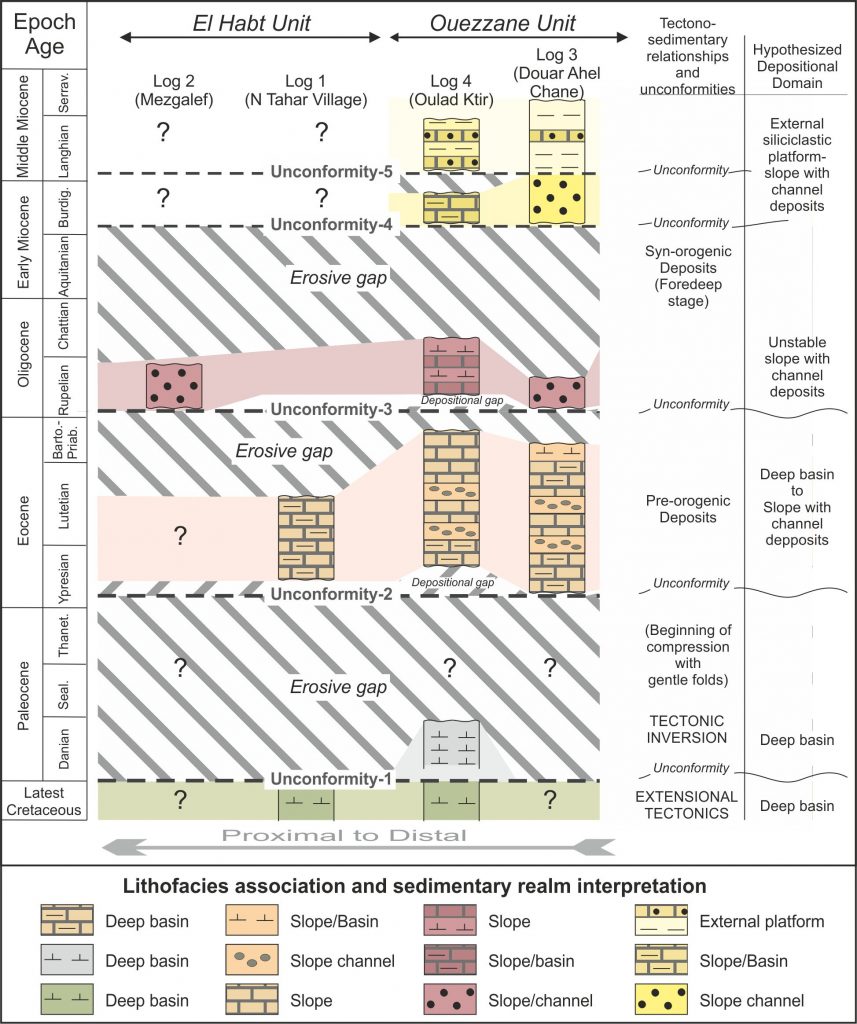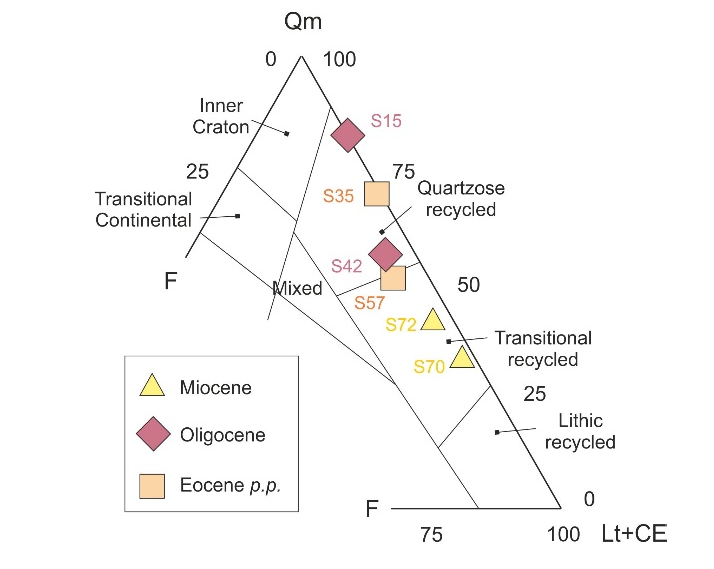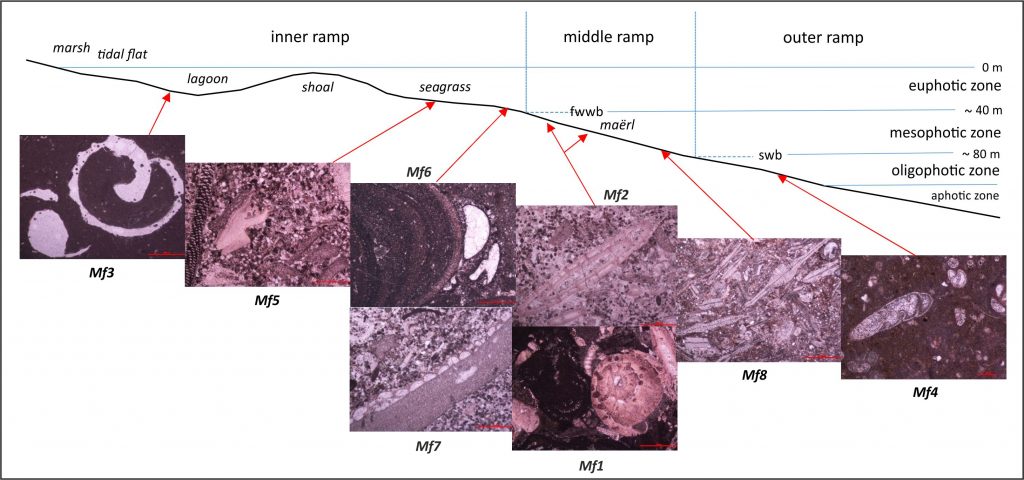Tectono-sedimentary Cenozoic evolution of the El Habt and Ouezzane Tectonic Units (External Rif, Morocco)
An interdisciplinary study based on lithostratigraphic, biostratigraphic, petrographic and mineralogical analyses has been performed in order to stablish the Cenozoic tectono-sedimentary evolution of the El Habt and Ouezzane Tectonic Units (Intrarif Subzone, External Rif, Morocco). The reconstructed record allowed identification of the depositional architecture and related sedimentary processes of the considered units. The Cenozoic successions were bio-chronologically defined allowing, at the same time, identification of unconformities and associated stratigraphic gaps.

The presence of five unconformities allowed to define the main stratigraphic units arranged in a regressive trend: (1) lower Paleocene interval (Danian p.p.) assigned to a deep basin; (2) Eocene interval (lower Ypresian-lower Bartonian p.p.) from a deep basin to an external carbonate-siliceous platform; (3) lower Rupelian-upper Chattian p.p. interval deposited on unstable slope with turbidite channels passing upward to an external siliciclastic platform; (4) Burdigalian p.p. interval from a slope; (5) Langhian-Serravallian p.p. interval from slope to external platform realms. The petrography of the arenites and calcarenites allowed to identify supplies derived from erosion of a recycled orogen (transitional and quartzose sub-types).

The clay-mineralogy analysis indicates an unroofing (first erosion of Cretaceous terrains followed by upper Jurassic rocks) always accomplished by erosion of Cenozoic terrains. Several tectofacies checked in some stratigraphic intervals seems to indicate the beginning of deformation of the basement generating gentle folds and first activation of blind thrusts, mainly during the Paleogene. A pre-orogenic tectonic framework is considered as risponse to the generalized tectonic inversion (from extension to compression) as frequently registered in the central-western peri-Mediterranean areas. The large volumes of reworked terrigeneous supply during the latest Oligocene-Miocene p.p. indicates the beginnigs of the syn-orogenic sedimentation (foredeep stage of the basins) controlled by active tectonics.
Sedimentary History and Palaeogeography of the Cenozoic clastic wedges of the Malaguide Complex, Internal Betic Cordillera, Southern Spain
The Cenozoic sedimentary cover of the Malaguide Complex (Internal Betic Cordillera, Spain), in the Almería and Málaga areas, consists of a suite of sedimentary successions from continental and shallow-marine to deep-marine environments. Structural and stratigraphic relations, and petrological and geochemical signatures reveal the sedimentary evolution of the Cenozoic Malaguide Complex (CMC) from pre-orogenic (Palocene-Eocene) to syn-orogenic (Oligocene-Early Miocene) stages.

Sandstones detrital modes of the overall succession are heterogeneous testifying to a multi-source area, marked by exhumation of the Malaguide basement terranes and of the Internal Betic Zone (Alpujárride Complex) in lower position. Pre-orogenic and syn-orogenic strata consist of four main depositional sequences: the Mula Group (Paleocene), the Xiquena Group (Eocene) for the preorogenic successions; and Ciudad Granada Group (Oligocene-Aquitanian) and Viñuela Group (Burdigalian) for the synorogenic successions. Pre-orogenic strata evolve from intra-arenite to hybrid arenites to progressive increase of sandstones in abundance of detrital supply from sedimentary cover of the internal Betic units. The unroofing history of the internal Betic Units, predominantly in the Malaguide Complex, is clearly testified in strata of the synorogenic clastic units, where detrital supply is coming from the Malaguide Complex. Sedimentary lithic fragments were derived from the Mesozoic strata of the Malaguide Complex while metamorphic detritus is related to the Internal Betic Zone basement that was exhumed starting from the Oligocene. Pre-orogenic mudrocks mainly show abundance of calcite and dolomite over quartz and phyllosilicates. Syn-orogenic mudrocks, record an abrupt decrease in calcite and dolomite and an increase of phyllosilicate, quartz and feldspars mainly in the Malaga section. The geochemical signatures attest to a compositional variation of the samples from pre-to-synorogenic successions, with palaeoweathering indices showing moderate values and a weak up-section decrease. The Cenozoic Malaguide Complex played a key role in the geodynamic evolution of the Betic Cordillera, representing the key tectonic element of the western Mesomediterranean domains.

Cite as: Critelli, S., Martín-Martín, M., Capobianco, W., Perri, F., 2021. Sedimentary history and palaeogeography of the Cenozoic clastic wedges of the Malaguide Complex, Internal Betic Cordillera, southern Spain. Mar. Pet. Geol. 124, 104775. https://doi.org/https://doi.org/10.1016/j.marpetgeo.2020.104775


Recent Comments